MSI 970 Gaming Motherboard Review: Undercutting AM3+ at $100
by Ian Cutress on January 22, 2015 10:00 AM EST- Posted in
- Motherboards
- AMD
- MSI
- Vishera
- AM3+
CPU Performance
Readers of our motherboard review section will have noted the trend in modern motherboards to implement a form of MultiCore Enhancement / Acceleration / Turbo (read our report here) on their motherboards. This does several things, including better benchmark results at stock settings (not entirely needed if overclocking is an end-user goal) at the expense of heat and temperature. It also gives in essence an automatic overclock which may be against what the user wants. Our testing methodology is ‘out-of-the-box’, with the latest public BIOS installed and XMP enabled, and thus subject to the whims of this feature. It is ultimately up to the motherboard manufacturer to take this risk – and manufacturers taking risks in the setup is something they do on every product (think C-state settings, USB priority, DPC Latency / monitoring priority, memory subtimings at JEDEC). Processor speed change is part of that risk, and ultimately if no overclocking is planned, some motherboards will affect how fast that shiny new processor goes and can be an important factor in the system build.
As it stands, it would seem that while the MSI 970 Gaming does not implement any form of MultiCore Turbo, its turbo mode is a lot more aggressive than our previous data points in most benchmarks.
Point Calculations – 3D Movement Algorithm Test: link
3DPM is a self-penned benchmark, taking basic 3D movement algorithms used in Brownian Motion simulations and testing them for speed. High floating point performance, MHz and IPC wins in the single thread version, whereas the multithread version has to handle the threads and loves more cores. For a brief explanation of the platform agnostic coding behind this benchmark, see my forum post here.
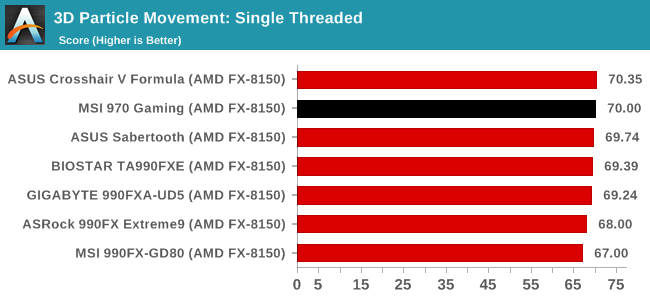
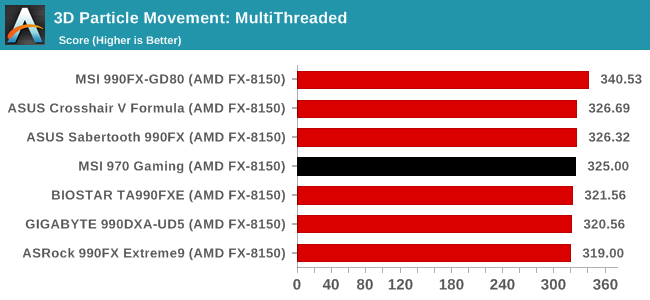
‘More aggressive turbo’ for 3DPM means a 2% jump in both ST and MT scores over the Extreme9.
Compression – WinRAR 5.0.1: link
Our WinRAR test from 2013 is updated to the latest version of WinRAR at the start of 2014. We compress a set of 2867 files across 320 folders totaling 1.52 GB in size – 95% of these files are small typical website files, and the rest (90% of the size) are small 30 second 720p videos.
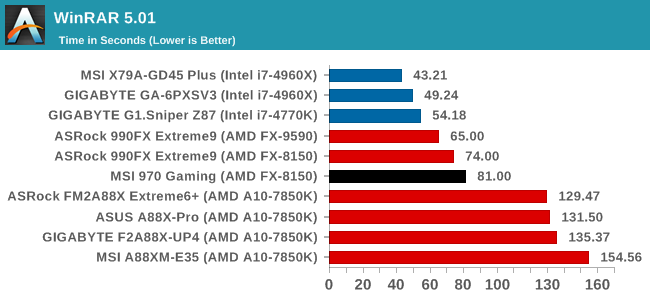
One benchmark where the turbo fails is in WinRAR, which uses a multithreaded load. We tracked the CPU MHz during this test and it did not show anything toward, perhaps indicating a more auto-memory timing issue. The 970 does come as standard with a slower HyperTransport link, which might be one of the reasons for the discrepancy.
Image Manipulation – FastStone Image Viewer 4.9: link
Similarly to WinRAR, the FastStone test us updated for 2014 to the latest version. FastStone is the program I use to perform quick or bulk actions on images, such as resizing, adjusting for color and cropping. In our test we take a series of 170 images in various sizes and formats and convert them all into 640x480 .gif files, maintaining the aspect ratio. FastStone does not use multithreading for this test, and thus single threaded performance is often the winner.
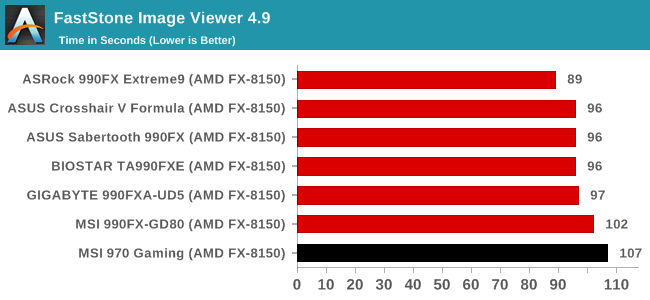
In line with the WinRAR result, the FastStone result was down the pan compared to the Extreme9 and other 900 series boards. FastStone is typically all CPU MHz related, especially single thread, which shows perhaps something fundamental with the 970 Gaming BIOS coding.
Video Conversion – Handbrake v0.9.9: link
Handbrake is a media conversion tool that was initially designed to help DVD ISOs and Video CDs into more common video formats. The principle today is still the same, primarily as an output for H.264 + AAC/MP3 audio within an MKV container. In our test we use the same videos as in the Xilisoft test, and results are given in frames per second.
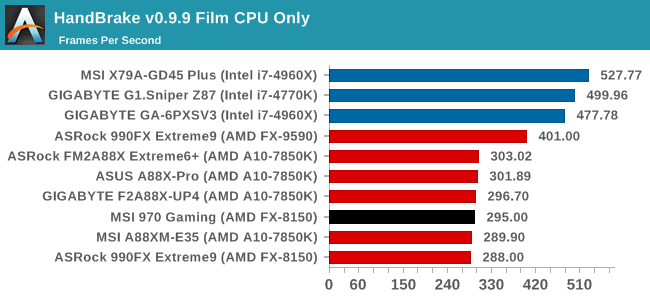
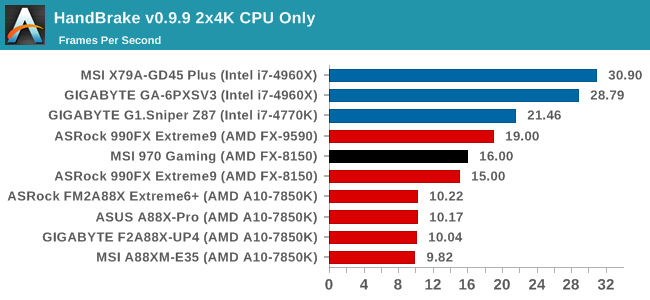
When the system ramps up all the cores, performance from the board is back on track, giving the same percentage increases over the Extreme9 as in the 3DPM benchmark.
Rendering – PovRay 3.7: link
The Persistence of Vision RayTracer, or PovRay, is a freeware package for as the name suggests, ray tracing. It is a pure renderer, rather than modeling software, but the latest beta version contains a handy benchmark for stressing all processing threads on a platform. We have been using this test in motherboard reviews to test memory stability at various CPU speeds to good effect – if it passes the test, the IMC in the CPU is stable for a given CPU speed. As a CPU test, it runs for approximately 2-3 minutes on high end platforms.
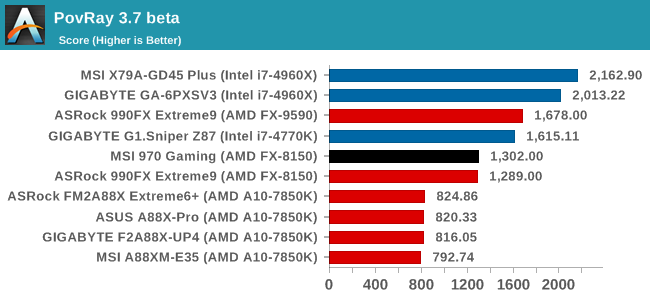
Synthetic – 7-Zip 9.2: link
As an open source compression tool, 7-Zip is a popular tool for making sets of files easier to handle and transfer. The software offers up its own benchmark, to which we report the result.
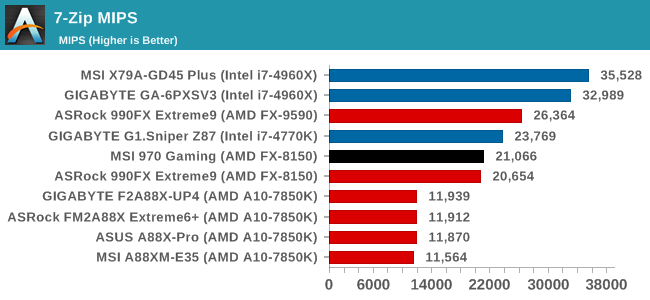










37 Comments
View All Comments
Stuka87 - Thursday, January 22, 2015 - link
I am actually in the market to replace my old Phenom II system (965BE @4GHz with an HD7950). And as nice as the price is for newer AMD stuff, even at the same price the performance is just not there for gaming. Too many games are poorly coded and only use two threads, so even with my current CPU two cores sit there doing nothing. With an 8320e, 6 cores sit there doing nothing. And the IPC improvements from Phenom II to current FX chips is marginal at best.Its just disappointing that gamers basically HAVE to go Intel to run any current games decently.
JarredWalton - Thursday, January 22, 2015 - link
It all depends on what you're trying to run. A very large number of games are going to be GPU limited, so much so that it really has no meaning what CPU you're running unless you're at medium to high quality settings in order to boost frame rates. We could also trot out Mantle and DX12, which should make the CPU matter even less -- but only on games that use those APIs, which is not the vast majority of games out right now or even coming this year.So yeah, if you're buying a new motherboard and CPU, it's hard to find a reason to buy an FX chip right now. If you already own one, you don't necessarily need to upgrade, but that's a different matter.
Stuka87 - Thursday, January 22, 2015 - link
Mantle is a huge boost. BF4 is near unplayable for me in multiplayer with DirectX, but runs "ok" in mantle (average 45fps, CPU limited with all four cores pegged). In that game an 8 core FX would help a lot. But then you go to a Blizzard game like Heroes of the Storm, and I am stuck with 2 cores pegged. A low end i3 outperforms my system (and FX systems) in these cases by quite a large margin.eanazag - Thursday, January 22, 2015 - link
Blizzard games always seem to be CPU heavy. It enables them to run the software decent on almost any kind of hardware. They build for Macs and many use the Intel IGP.Alexvrb - Thursday, January 22, 2015 - link
This is true and in some ways Blizzard's engines are very well optimized. They don't lean too hard on the graphics (at least at fairly moderate settings) and they look good even if you don't have a fast enough system to crank on all the eyecandy. They run well on systems with few cores, too. Both of these things tend to make them fairly laptop-friendly as well. But they're not very well threaded and the downside is that if you've got a system with relatively low per-thread performance and 4+ cores you're often going to have an unnecessarily poor experience as it simple can not take advantage of your setup.piteq - Friday, January 23, 2015 - link
I will jump in here with a question. Considering myself a WoW player and AMD supporter (that's a weird combo for sure ;-) ), I look for some options to upgrade my Phenom II X4 965 (3,5 GHz, it's not OC-ing well) and Radeon 6790 /w 1GB GDDR5 (which is noisy…). I realize, the improvement won't be huge, but I think about: Vishera 8320E, some mobo (Asus M5A99X EVO R2.0? Or maybe there are better ones for the price) and some much more silent GPU (R7 265 / R9 270? Or maybe there's something not much more expensive and better?). Do you think I will notice some justifable difference? :)HappyHubris - Friday, January 23, 2015 - link
From a X4 965 you really have no viable upgrade path.According to Anandtech's benchmark, upgrading from a X4 965 to FX 8320E would give you
HappyHubris - Friday, January 23, 2015 - link
From a X4 965 you really have no viable upgrade path.According to Anandtech's benchmark, upgrading from a X4 965 to FX 8320E would give you less than 10% improvement in average FPS:
http://www.anandtech.com/bench/product/102?vs=698
It looks like a Haswell i3 would be quite an upgrade, based on the SB i3 performance vs. AMD parts:
http://www.anandtech.com/bench/CPU/62
piteq - Monday, January 26, 2015 - link
Thank you! Eh, seems AMD marketing should never, ever show WoW results to anyone ;) Ineed, if not i3, then i5 seems to much more sensible path, especially it's not THAT more expensive thank 8320E. Well, it's just a weird, very bad for AMD case, still…FlushedBubblyJock - Sunday, February 15, 2015 - link
Buy a GTX970, you're done.